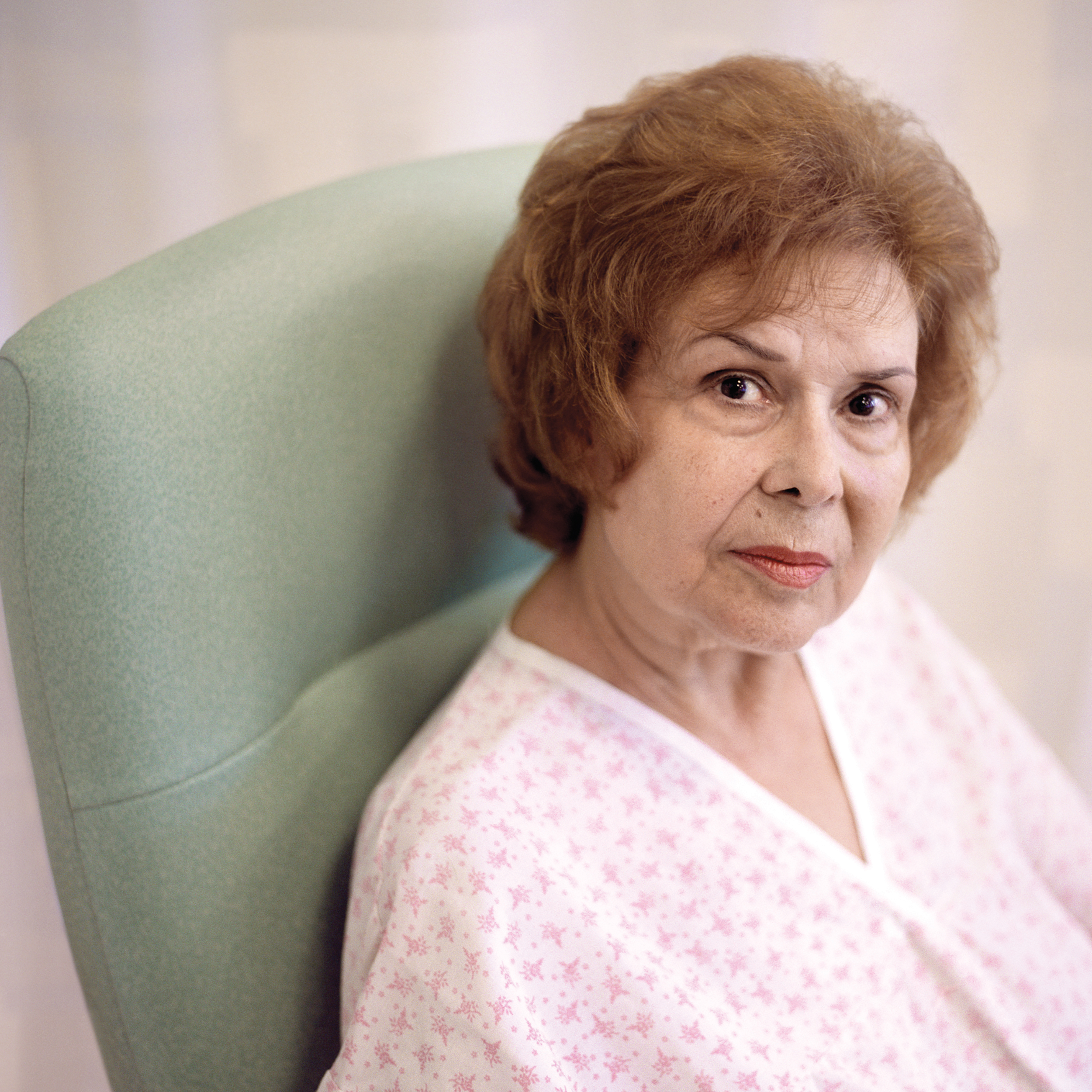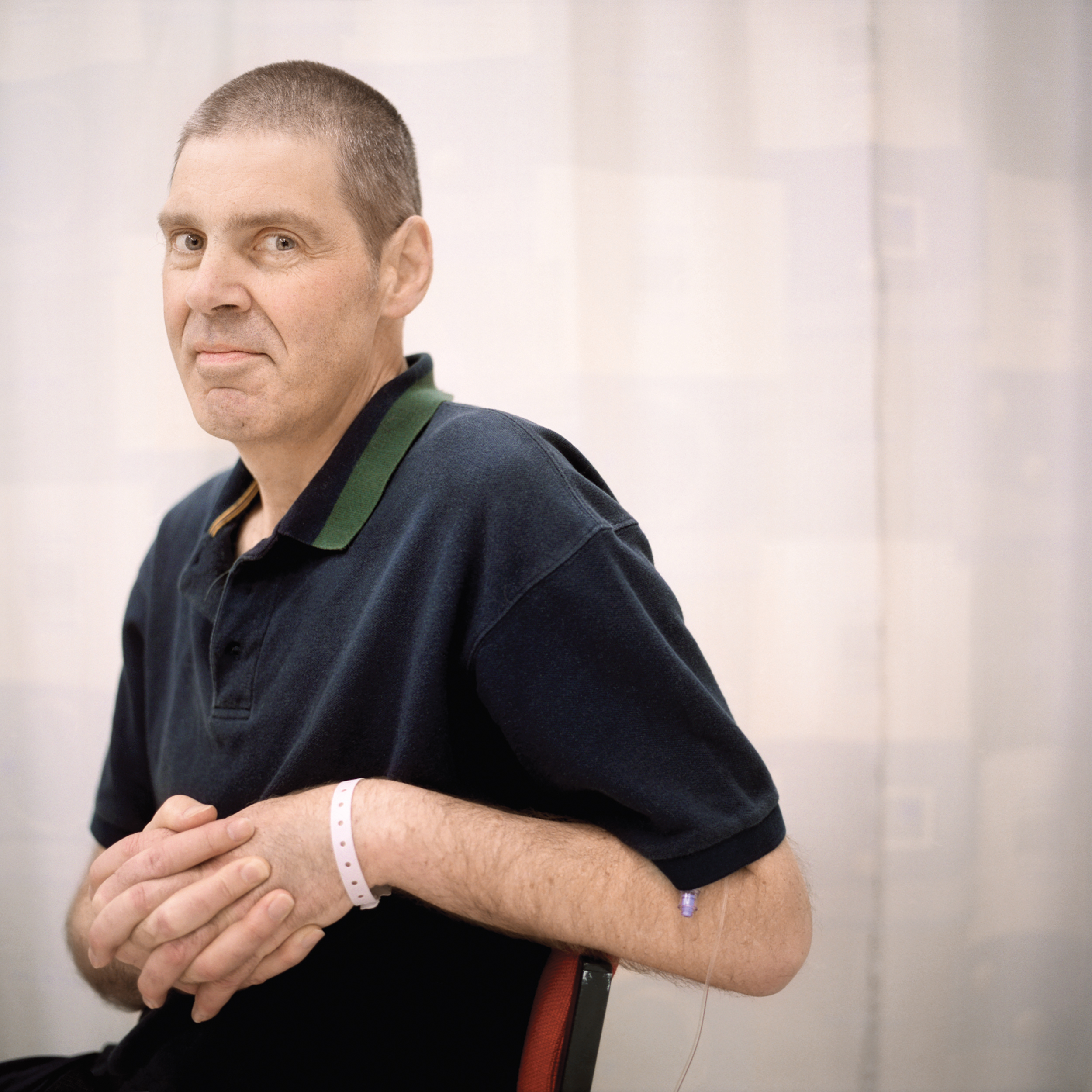I was artist in residence at The Royal Marsden Hospital in London exploring the lives of people living with cancer.
To me, cancer has been a comma, a comma
in the sentence that represents my life.
I'm in need of one of my mum's steak and kidney pud dinners.
You know, I gave my power away.
I had to take it back.
I'm getting a mastectomy. Well at least I'll get
a better set of boobs out of it.
When you get up early in the morning, there are reflections
dancing across the ceiling.
My sunny bright day helps the mind to soothe with the
view outside. I'm sorry, my English is not very good.
Rejoice with the Lord always, and again I say, rejoice.
I've been having chemicals for eight years. I'm getting
older now and I don't know if I can take it anymore.
I think of the outdoors, I think of the space.
I have lost my hair three times and it comes back
different every time, different colour or wavy.
It's difficult to get used to being dependent and that's
the first thing hospital does to you.
I'm 92 and I've never been ill, but
I've come through this nicely.
You know, I'm just bloody angry.
My husband is here too, we both have cancer. We sat side by side in
chemotherapy, I thought, this is taking togetherness a bit far.
I've got Monday morning face today, when it hits you, it hits you.
Every time you open your eyes in the morning and see
another day, it doesn't end, it's always there.
I worked for the same firm for 34 years.
I was a horror for changing jobs.
That's a joke.
Luckily, when I was told that I had lung cancer and a
short time to live, my wife was with me,
who I love with all my being.
I believe in angels but at some point mine lost his way.
Now he's finding his way back to me.
I have my hair done every Thursday at nine. Having my
hair and hands done makes me feel more complete.
The surgeon told my husband I had six months to live.
He just drove to Asda and bawled his eyes out.
I felt shocked and like my body had let me down.
I've learned that there is another side to life.
Now I have started to learn patience, which
is something that I have never done in my life.
Somebody phoned me and said, 'how are you?'
I said, 'I'm awake, thats the main thing.
If you wake up, you know you've made it.'
There is nothing good in my thoughts.
My hair sounds like straw.
Some of my friends just could not handle it.
I felt abandoned.
I pray for normality. I want my body back.
Everyone in my street thinks I'm a big fraud
because I look so well.
Mine's not a hip hap hoppy situation. It's terminal.
Cancer is a great leveller. It makes you realise,
we are all the same.
I miss the open air. I miss my strength and I miss
the assumption that I'm indestructible.
EVERY DIFFERENCE IS A LIKENESS
It strikes me as a happy coincidence that this show of Tim Wainwright’s work should be being held during an exhibition at the V&A of Diane Arbus’s. Arbus was the mistress of the grotesque, the high priest of freaks: the mad, the blind, the ungainly, gigantic, the oddly coiffed. Among many others, the novelist Eudora Welty attacked her as a pornographer of misfortune, a gawper at other people’s tragedy. But Welty was wrong.
Look at any of Arbus’s photographs – Superstar at Home, Girl with Blonde Hair, A Child Crying– and you’ll see freakery. Look at them all and you’ll notice something else: what Susan Sontag called “insistent sameness”, an absolute equality of treatment. This isn’t to say that Arbus was a one-trick pony, but that everyone – the rich, the poor, the beautiful, the deformed – was equal in the eyes of her law. Far from seeing her subjects as freaks, she saw them as they saw themselves; which is how we all see ourselves, which is as ourselves. One of Arbus’s best-known dictums was that “every difference is a likeness, too”. In all their oddity, all their otherness, her subjects are as we are.
Wainwright’s pictures are of cancer sufferers: some of them evidently so, thin-faced and big-eyed or with the appurtenances of hospital treatment – oxygen tubes, intravenous drips – hanging from their noses or around their necks or over their arms. As with Arbus’s subjects, we find ourselves conjuring up a story as we look at them: Wainwright approaching his subjects to be photographed; some of them accepting, some of them refusing; some of them agreeing to have their pictures taken as still lifes rather than portraits. For me, it is these last images that are the most eloquent. We are not allowed to look at the woman whose husband bawls his eyes out in Asda: all that is shown is a clock, a fugitive symbol of fugitive lives. The patient whose friends couldn’t handle his cancer, perhaps in truth, couldn’t handle it himself. The skeletal coat-hanger that stands in for him tells of his own sense of abandonment; his inability to face mortality, the skull beneath the skin.
And yet, with Wainwright as with Arbus, there is no sense of hierarchy in these portraits, no air of judgement. Sontag spoke of Arbus’s “calm, matter-of-fact attentiveness”, and that is what we feel in the works here. Wainwright’s aim, it seems to me, isn’t to impose his view on his subjects: to suggest, for example, that the people who appear to deal more cheerily with their illness – the woman who jokes about getting a mastectomy for her ruby wedding anniversary – are any better or braver than the ones who hide their faces. One of his happiest portraits is of a pair of women’s feet clad in red shoes. She’s is represented by her footwear, you feel, not because she can’t look herself in the face but because maybe her feet sum up her optimism better than her face does.
So what are these pictures about? I’d say the word was, complicity. Faced with illness – above all with cancer – we turn people into mirrors. Instead of seeing cancer patients as they see themselves, we project our own fears onto them: in their hollow eyes and Hickman lines we find reflections of our own dying. What it’s like to be on the other side of the mirror – on the inside looking out – is almost impossible for us to imagine. We convince ourselves that some of them are braver than we’d be in their place, some of them less brave. Wainwright’s aim, I’d say, is to let us see that there is no they; that people with cancer are exactly as brave or fearful as anyone else; that every difference is a likeness, too.
I suppose what I’m tying to say is that all the portraits in this show are, on some level, self-portraits. One of the paradoxes of the camera is that it is both an intensely subjective instrument and an entirely impersonal one: Wainwright exploits this paradox to look without being seen. His reticent photographs – naturally lit, devoid of tricks or props – tell us little about the man who made them or what he thinks of his task. Far from being made into mirrors for his own fears, Wainwright’s subjects are allowed to speak for themselves: to fret about the dryness of their hair or boast of their prowess at bowls; to hide their faces, to rage against the dying of the light. His interest isn’t in showing the differences in their self-image – desperate, triumphant, funny, numb – but simply in observing that each of them has a self-image. Just before his own death, Roland Barthes spoke of the “flat death“ that every photograph contains – the knowledge that the instant it captures is inherently gone forever. Brave or frightened, with good or bad prognosis, that will one day be true of all the people in these photographs; and of all of us.
Charles Darwent (writer and art critic)






























